Rural-Urban Fringe | Geography Optional for UPSC PDF Download
Introduction
- Urban sprawl refers to the horizontal expansion of a city as it consumes the surrounding landscape. This process of urban growth has been particularly notable since the end of World War II, with the development of megacities and urban corridors along major transportation routes. This growth has led to suburban areas, industrial suburbs, and townships emerging around cities, taking over rural landscapes. These areas are characterized by a mix of urban and rural land uses, as well as a blend of city and countryside lifestyles.
- In 1951, American land economist H.M. Meyer first coined the term "rural-urban fringe" to describe the transitional zone between urban and rural areas, where both urban and rural land uses and practices coexist. The rural-urban fringe is the area where the city meets the countryside, characterized by a mix of agricultural and urban land uses. This zone is located within the city's sphere of influence and often includes residential communities for middle-income commuters who work in the city center.
- Several scholars have attempted to distinguish between different types of rural-urban fringe areas. In 1958, Kurz and Fletcher sought to differentiate between fringe and urban areas, while in 1961, Wissink used the terms fringe, suburb, and pseudo suburb. The rural-urban fringe is often overlooked because it lies outside the city's administrative boundaries. Consequently, various names have been used to describe this area, such as "peripheral zone" by Burgess and "Out Urban Area" by the Census of India, while others refer to it as the "Rural-Urban Continuum."
In summary, the rural-urban fringe refers to the transitional zone between city and countryside, characterized by a mix of urban and rural land uses and lifestyles. This area has grown significantly since the end of World War II, particularly along major transportation routes. Despite being a crucial part of urban growth, the rural-urban fringe is often neglected due to its location beyond the city's administrative limits.
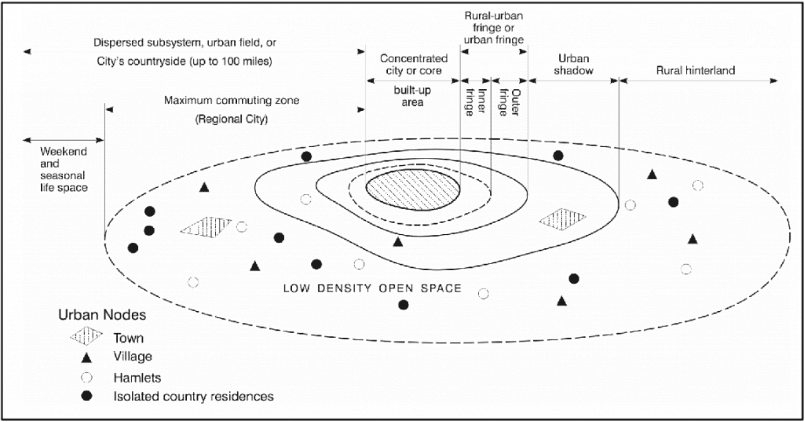
History of rural-urban fringe development
The term "urban fringe" has evolved over time, with its origins tracing back to Vonthunen in 1826, who described the city as being surrounded by concentric belts of land use. Various contributors, such as Jonason, Douglass, Mckenzie, Park, Burgess, Makaye, Christaller (who developed the Central Place Theory), Hoyt, Colby, and others, have discussed the concept of the urban fringe in different ways.(i) In 1940, Salter characterized it as a region with a mix of urban and rural land uses.
(ii) In 1945, Balk referred to it as an area of urbanization.
(iii) In 1962, Wehrwein called it suburban development.
(iv) In 1960, Russwarm described it as a discontinuous area.
(v) In 1962, G.A. Wissink named it "An Area of Great Differentiation."
(vi) Indian scholars like R.L. Singh referred to it as rural land with urban phenomena, while M.M.P. Sinha defined it as a narrow zone outside the political boundaries of an urban unit, characterized by neither urban nor rural features.
- Following World War II, there was significant inner-city development, but it did not create enough housing for everyone. Consequently, some residential areas were built on the outskirts of towns and cities. As housing expanded into the suburbs, population density decreased, and houses became larger due to cheaper land.
- The expansion of residential areas into the suburbs led to the development of transportation networks, improving connectivity between suburban and inner-city regions. From the 1970s onwards, out-of-town shopping centers capitalized on lower land prices and increased space. Similarly, many companies relocated their offices and factories to the urban fringe to take advantage of better transport links and lower building costs.
From the late 1970s, many cities experienced population loss due to counter-urbanization, as people left cities for various reasons:
(i) Seeking a better quality of life in quieter, cleaner rural surroundings
(ii) Increased willingness and ability to travel longer distances to work
(iii) Businesses relocating to areas with better transport links and cheaper building costs
(iv) The rise of flexible working and new technologies enabling part-time home working
(v) Retired individuals leaving the city where they once worked.
This trend led to the expansion of smaller towns and villages with excellent communication links, resulting in a lot of "in-filling" or building within existing village or town boundaries.
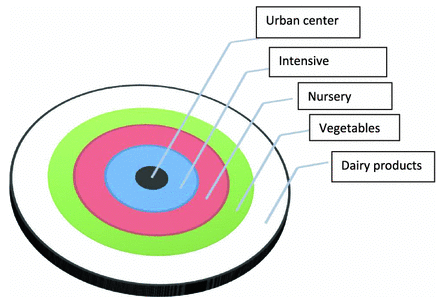
Characteristic of Rural-Urban Fringe
- Land use characteristics: The land use patterns in the rural-urban fringe are constantly evolving. Residential areas are expanding rapidly, resulting in small farms with intensive crop production. The development of science and business parks is also prevalent in these areas, along with airport expansions. Public facilities and services, however, are often inadequate in these regions. Speculative building is also common, as developers anticipate future growth and demand.
- Social characteristics: Segregation: The rural-urban fringe, also known as "Greenfield sites" (undeveloped areas outside the existing urban zones), is often favored by large companies seeking locations for new developments, such as headquarters, offices, housing, and industrial estates. This leads to functional and social segregation of land use, with different areas designated for specific purposes.
- Selective Immigration: The rural-urban fringe tends to attract middle-class residents, who make up a small yet economically significant portion of the city's population. Due to the inadequate public facilities and services in these areas, many residents may choose to move elsewhere, resulting in selective immigration patterns.
- Commuting: Many people living in the rural-urban fringe area commute daily to their workplaces in urban centers. This leads to traffic congestion within the city, as the local government must provide transport services capable of handling peak loads. The daily influx of commuters also puts pressure on the city's infrastructure and resources.
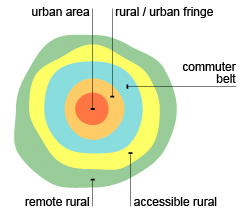
Delimitation of rural urban fringe
Identifying the boundaries of fringe areas can be challenging, as various scholars have provided different perspectives on the matter. The characteristics and functions of these areas may differ from one city to another, and numerous factors have been considered in determining these boundaries. There are two primary methods of demarcation for rural-urban fringe areas: the empirical method and the statistical method.1. Empirical method
The empirical method is a traditional approach that focuses on the continuous built-up area as the basis for delineating fringe areas. Several scholars have contributed their techniques for demarcating these areas, including Smith (1937), Andrews (1942), M.W Rodehaver, W.T Martin (1957), S.W Blizzard and W.F Anderson (1962), D. Mukherjee (1963), Oosthwizen (1969), R.J Prayor, M.K Srivastava, and Ujagir Singh. The following factors can be used as a starting point for delimiting the rural-urban fringe zone:
(i) Changes in land use
(ii) Changes in the built-up area
(iii) Occupational structure of the population
(iv) Types of houses
(v) Distribution of industrial and non-agricultural activities
(vi) Limit of essential services
(vii) Distribution of educational institutions.
Based on direct observation, the rural-urban fringe area is generally considered to be within 10-20 km from the city's municipal limits. The Census of India has established the following criteria for defining fringe areas:
(i) Population density should be less than 400 persons per square kilometer
(ii) The decadal population growth rate should be at least 40%
(iii) The sex ratio should be higher than 800 females per 1000 males (due to outmigration for work)
(iv) The city's outer limit should be serviced by buses or local trains
(v) 50% or more male workers should be involved in non-agricultural occupations.
Statistical Method
Dr. M.M.P. Sinha applied statistical methods to demarcate urban fringes in 1980. He began by determining the influence area using Isochrone, considering the word limit as 100 (T). Any area outside this was considered 0, and the urban index was calculated between 0 and 100, assigning values to the number of villages.
- He then found correlations between various factors of the villages, excluding those with values below 30 and -30. The mean value of the remaining factors was taken, which is referred to as the scale of urbanity.
- It was observed that as we move away from the city, population density decreases, and the sex ratio increases, resulting in a positive correlation.
- Some notable studies on urban fringes in India include R.L Singh's work on Varanasi fringe, Harihar Singh's study of Kanpur fringe, Ujagir Singh's research on KAVAL cities, K.N Gopi's analysis of the Hyderabad metropolitan fringe, MMP Sinha's work on Patna fringe, Sudesh Nangia's study of Delhi metropolitan fringe area, and Hiralal's research on Bareilly fringe.
Today, urban fringes can be classified into two categories:
(i) Inner fringe zone, also known as the area of convenience
(ii) Outer fringe zone, known as the slowly progressive zone.
Types of Rural Urban Fringe
The rural-urban fringe is a constantly evolving area that changes its shape and boundaries as urban facilities expand. This transitional zone can be classified into two main categories:- Primary urban fringe: This zone is directly adjacent to the outer administrative boundary of the city. As a result, it experiences rapid development of urban facilities and various activities. This area has been referred to by different names, such as "urban fringe" by Andrews, "Reinmann" by outlying adjacent areas, "True fringe" by Myres and Beegle, "Inner fringe" by Whiteland, and "Inner fringe or urban-suburban fringe" by MMP Sinha.
- Secondary urban fringe: This area lies beyond the primary urban fringe and is characterized by having predominantly rural features that have developed at a slower pace. The presence of urban functions in this zone is significantly reduced compared to the primary urban fringe.
In summary, the rural-urban fringe is a dynamic and evolving region that can be divided into two main areas: the primary urban fringe, which is directly adjacent to the city and experiences rapid development, and the secondary urban fringe, which is further from the city and maintains more rural characteristics with slower development.
Structure of Rural Urban fringe
The urban-rural fringe can be understood as a transitional area between urban and rural landscapes, characterized by a mix of land uses and activities. It consists of various zones, each with distinct features:
- Urban fringe: This zone is marked by suburban growth, urban corridors, housing developments, and village panchayats that have transformed into new residential urban villages. It represents the expansion of urban areas into the surrounding countryside, with a blend of urban and rural characteristics.
- Rural fringe: This area comprises a mix of urban and rural land uses, including facilities such as crematoriums, sewage treatment plants, polluting industrial units, and industrial slums. It also features disorganized growth of urban commercial markets. Although rural land use still prevails in this zone, changes in occupation patterns are more noticeable than changes in the landscape. This area often serves as a dumping ground for city waste.
- Urban shadow: This zone represents the potential area of future urban fringe expansion, experiencing increasing pressure on land due to urbanization. It is mostly characterized by market gardening and retains a predominantly rural nature. However, land prices in this area are rapidly increasing as it becomes more attractive to urban development.
- Daily urban system: Also known as the commuter's zone, this area consists of people who travel daily to the urban-rural fringe for various activities, such as buying and selling goods, conducting business, and engaging in commerce with city residents. Functionally integrated villages in this zone serve as suppliers to meet the daily demands of the city.
- City region: This encompasses the broadest possible area influenced by urban activities and represents the farthest reach of a city's impact on its surroundings.

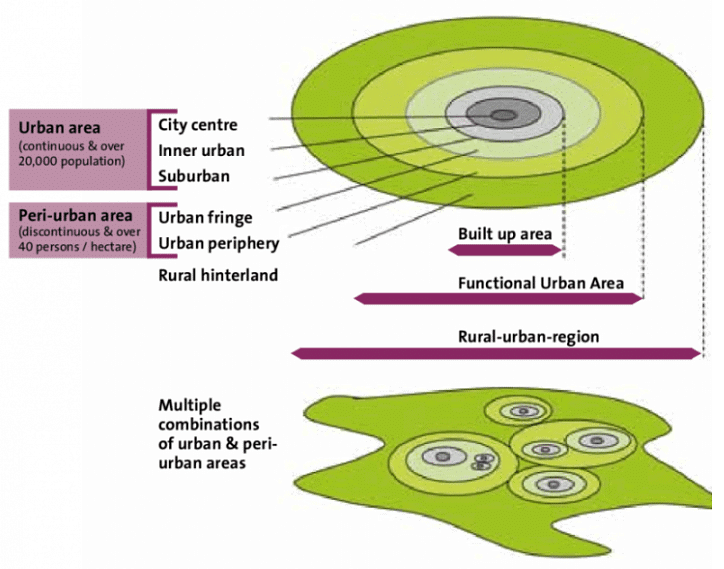
Stages of growth of Rural Urban fringe
The growth of the Rural-Urban fringe can be divided into several stages, as described below:- Rural stage: At this stage, the area is primarily agricultural, with intensive grain farming being the dominant land use. The local village culture and panchayat (village council) are predominant, and there is little to no urban influence.
- Agricultural land use transformation: As the city's influence begins to reach the area, agricultural practices change to meet the city's demands. Market gardening and dairy farming replace intensive grain farming.
- Occupational change: Agricultural laborers and cultivators start working in the city, often in the tertiary/service sector. Due to the increasing land costs, many farmers become landless as their agricultural land is acquired for urban purposes.
- Urban land use: Various urban facilities and structures, such as crematoriums, sewage treatment plants, airports, bus stations, industrial units, small townships, and suburbs, begin to develop in the area. Slum and squatter settlements may also emerge.
- Urban village stage: At this point, the rural landscape has been largely transformed into urban land use. Residential areas, hypermarkets, marketing centers, and wholesale markets are established. This stage is characterized by unplanned and haphazard growth, leading to urban problems. As a result, urban policies and redevelopment plans are needed to address these issues and integrate the urban village with the main city.
Problems of Rural Urban fringe
- Disorganized and chaotic development: The rural-urban fringe often experiences unplanned and haphazard growth, leading to various issues such as inadequate infrastructure and inefficient land use.
- Urban waste and pollution: The outskirts of cities often become dumping grounds for urban garbage, leading to land and groundwater pollution in these areas.
- Negative environmental facilities: Facilities like crematoriums and sewage treatment plants are often located in fringe areas, causing potential health and environmental concerns for nearby residents.
- Slums and related issues: The lack of proper planning and infrastructure in the rural-urban fringe can result in the development of slums, which brings along problems such as overcrowding, poor sanitation, and increased crime.
- Land ownership and speculation: The rural-urban fringe often experiences a concentration of land ownership, speculation, and rapidly increasing land values, which can lead to disputes and conflicts among residents.
- Relocation of polluting industries: Industries that cause pollution are often shifted to fringe areas, putting the health and well-being of nearby residents at risk.
- Crime and cultural clashes: The interaction of urban and rural cultures in the fringe area can lead to an increase in crime and vandalism, as the differing temperaments and values may cause friction between communities.
- Social and psychological changes: The rapid changes and disruptions occurring in the rural-urban fringe can lead to social and psychological adjustments, with traditional beliefs being challenged and families and societies facing upheaval.
- Inadequate infrastructure: Lack of essential utilities such as water supplies, sewage disposal, and well-planned streets can significantly impact the quality of life in the rural-urban fringe.
- Administrative and financial challenges: Small towns and revenue villages in the fringe area often lack the necessary administrative and financial infrastructure, leading to difficulties in providing essential services and managing growth.
- Poor public transport facilities: The rural-urban fringe is often underserved by public transport, making it difficult for residents to access jobs, education, and other opportunities in urban areas.
Reason for development of rural urban fringe
- The development of rural-urban fringe areas, which can also be referred to as the Rural-Urban Continuum, is driven by various factors. These factors can be grouped into internal and external forces that push and pull people to settle in these areas.
- Internal factors are those which encourage people to leave cities and settle in the outskirts. These factors include the increasing cost of land rent due to limited space within cities, environmental degradation, a lack of residential housing, and the growing demand for land for functions that cannot be performed within city boundaries.
- External factors, on the other hand, act as pull factors that draw people to fringe areas. These factors include improved commuting facilities (such as developed transportation), lower land costs, exemption from certain municipal taxes, and environmental stability.
The development of rural-urban fringe areas is beneficial in many ways, as these areas offer a mix of land uses that require large spaces. Some examples of developments in these areas include:
- Housing developments that cater to the growing urban population and the desire for more spacious living environments.
- Science and business parks that provide opportunities for innovation, research, and collaboration.
- Hypermarkets and superstores that offer a wide range of products and services in one location, making shopping more convenient for consumers.
- Retail parks and out-of-town shopping centers that provide ample parking and a variety of shopping options.
- Office developments that offer modern and spacious working environments for businesses.
- Hotels and conference centers that cater to the needs of business travelers and event organizers.
- Airport expansions that accommodate the growing demand for air travel and contribute to the economic growth of the region.
In conclusion, the development of rural-urban fringe areas is driven by a combination of internal and external factors that encourage people to settle in these locations. These areas offer various land use opportunities that are beneficial to both residents and businesses, contributing to the overall growth and development of the region.
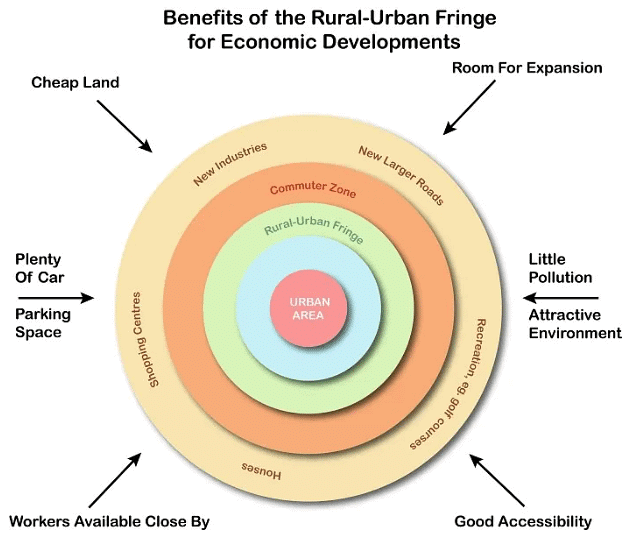
Conclusion
In conclusion, the rural-urban fringe is a dynamic and evolving area that lies at the intersection of city and countryside, characterized by a mix of urban and rural land uses and lifestyles. Since the end of World War II, this transitional zone has experienced significant growth, driven by various internal and external factors. Despite facing numerous challenges, such as disorganized development, pollution, and inadequate infrastructure, the rural-urban fringe offers various opportunities for residential, commercial, and industrial purposes. As urbanization continues to expand, understanding and addressing the complexities of the rural-urban fringe becomes increasingly essential for sustainable growth and development.Frequently Asked Questions (FAQs) of Rural-Urban Fringe
What is the main difference between the primary urban fringe and the secondary urban fringe?
The primary urban fringe is directly adjacent to the outer administrative boundary of the city and experiences rapid development of urban facilities and various activities. In contrast, the secondary urban fringe lies beyond the primary urban fringe and is characterized by having predominantly rural features that have developed at a slower pace.
How has urban sprawl contributed to the development of rural-urban fringe areas?
Urban sprawl has led to the horizontal expansion of cities, consuming the surrounding landscape and resulting in the development of suburban areas, industrial suburbs, and townships. These areas often lie within the rural-urban fringe, which is characterized by a mix of urban and rural land uses and lifestyles.
What are some of the main challenges faced by rural-urban fringe areas?
Some of the main challenges faced by rural-urban fringe areas include disorganized and chaotic development, urban waste and pollution, land ownership and speculation, relocation of polluting industries, crime and cultural clashes, social and psychological changes, inadequate infrastructure, administrative and financial challenges, and poor public transport facilities.
How does the rural-urban fringe contribute to traffic congestion and strain on city infrastructure?
Many people living in the rural-urban fringe area commute daily to their workplaces in urban centers, leading to traffic congestion within the city. The daily influx of commuters also puts pressure on the city's infrastructure and resources, as the local government must provide transport services capable of handling peak loads.
Why are rural-urban fringe areas attractive for businesses and developers?
Rural-urban fringe areas are attractive for businesses and developers due to lower land costs, exemption from certain municipal taxes, improved commuting facilities, and environmental stability. These areas offer ample space for various land uses, such as housing developments, science and business parks, hypermarkets and superstores, retail parks, office developments, hotels, conference centers, and airport expansions.
|
303 videos|636 docs|252 tests
|
FAQs on Rural-Urban Fringe - Geography Optional for UPSC
| 1. What is the rural-urban fringe? |  |
| 2. What are the characteristics of the rural-urban fringe? |  |
| 3. How is the rural-urban fringe delimited? |  |
| 4. What are the stages of growth of the rural-urban fringe? |  |
| 5. What are some challenges associated with the rural-urban fringe? |  |
















